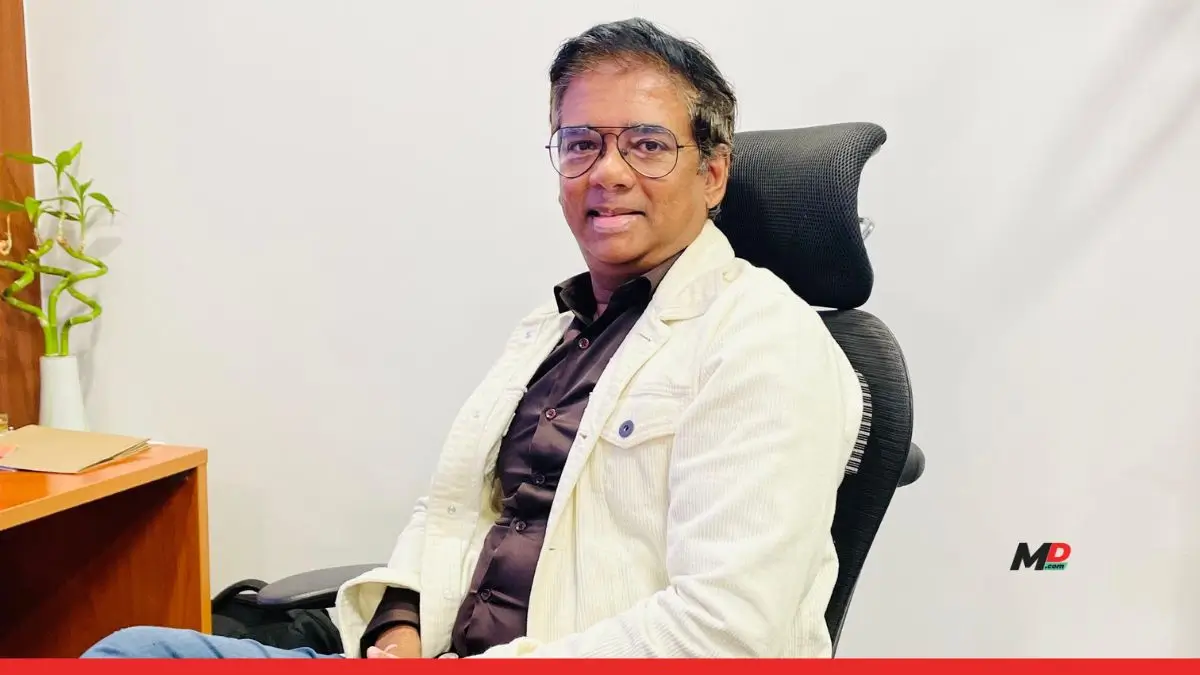Technology
“India is uniquely positioned to shine in IT over the next decade”: Lumen MD Soumitra Saha
Published
10 months agoon

In an exclusive conversation with Marksmen Daily, Senior Journalist Neeraj Tiwari spoke with Soumitra Shah, MD & Country Head of Lumen India, to discuss the key challenges and opportunities shaping India’s IT and network infrastructure industry. As India cements its position as a global technology powerhouse, the sector faces pressing challenges, including talent shortages, cybersecurity threats, infrastructure gaps, and regulatory complexities. However, with rapid advancements in digital transformation, connectivity, and cloud computing, the future of IT in India looks promising.
What are the biggest challenges the IT and network infrastructure industry in India needs to address to stay competitive globally?
The IT and network infrastructure industry in India faces several significant challenges that need to be addressed to stay competitive globally:
1. Growing Talent Competition: The rapid expansion of the technology sector in India, driven by the emergence of thousands of GCCs, has led to an unprecedented demand for proficient technology talent. The recent surge in demand of GCCs, with a projected workforce of 2.5 million to 3 million by 2030, has led to a fierce talent war in the region. Besides this, the vibrant start up ecosystem in India, with many of them offering attractive and competitive compensation and benefits, is fiercely adding to the talent competition.
2. Increasing Cyber Threats: With the increasing threat of cyberattacks, especially post COVID, organizations need to enhance their cybersecurity posture. This requires intentional investment to ensure a “no-compromise” strategy to ensure data security for clients. In addition, this requires implementing robust security measures and staying compliant with regulations.
3. Infrastructure Development: The rate of growth of the IT and network infrastructure industry in India far exceeds the rapid development in physical infrastructure, leading to stress in cities like Bangalore, which is the IT capital of the country. India needs world-class infrastructure, and metropolitan cities need better physical infrastructure, including power, roads, airports, and ports.
4. Regulatory Compliance: Ensuring compliance with various regulations, such as India Cert-IN and DOT regulations, is crucial for maintaining security and operational efficiency.
As cyber threats rise, businesses are prioritizing security measures. Spending on cybersecurity in India is expected to exceed $3.5 billion by 2025. Programs such as Digital India and Make in India are improving infrastructure and encouraging investments. Rural internet penetration is expected to surpass 50% by 2025. Overall, the future of IT in India is set to be shaped by these advancements, driving innovation and growth across various sectors. Addressing the challenges and leveraging these opportunities will be crucial for India’s IT industry to stay competitive globally.
How do you see the future of IT in India evolving over the next decade, particularly with advancements in connectivity and digital transformation?
The future of IT in India over the next decade looks incredibly promising, especially with the rapid advancements in connectivity and digital transformation. India is uniquely positioned to shine in IT over the next decade, for sure. The sheer growth of GCCs in India, rapid expansions of IT service companies, the thriving start up ecosystem and active intervention by the Government are factors fueling the growth of IT in India. India is witnessing and will continue to witness scales of digital transformation we have not seen so far.
India-now ranks third globally for the number of unicorns, boasting 90 unicorns as of 2024. Venture capital investments surged to $42 billion in 2024, demonstrating strong financial support. Government initiatives such as Startup India and Digital India have significantly contributed to this growth. With a user base of more than 500 million, a record 70 billion transactions in 2024 alone and 2.5 trillion USD worth of transactions, UPI in India has seen an unprecedented growth and is a testimony to the future potential of our country. The adoption and transaction data of UPI in 2024 underline its pivotal role in India’s digital economy.
The continued growth and evolution of UPI are indicative of a future where digital payments are ubiquitous, secure, and accessible to all. The rollout of 5G technology will be a game-changer for India’s digital landscape, providing faster and more reliable internet connectivity across the country. This will transform mobile experiences for millions of users and facilitate the adoption of IoT and smart city initiatives. The focus of the government in implementing a holistic data protection program is very commendable.
With the increasing threat of cyberattacks, what key measures should organizations take to enhance their cybersecurity posture?
For India to stay ahead of global competition in IT and network infrastructure, focus on cybersecurity is of paramount importance. There are several key measures that organizations and the Government need to take:
1. Enhance Identity and Access Management (IAM): Often underrated, and I cannot reiterate the importance of implementing a robust IAM practice across all organizations. Improving IAM practices is crucial as many security incidents have a significant IAM component. This includes managing privileged access effectively and ensuring tight control over who has access to sensitive information.
2. Implementing a zero-trust model: This is not a new concept in the industry. This model assumes that no one, whether inside or outside the network, can be trusted by default. Every access request must be verified, making the network more secure. I strongly believe that every company must adopt this model.
3. Implement a Robust Security Framework: Organizations need to adopt comprehensive security frameworks that include policies, controls, and technologies to protect against internal and external threats. Ensuring compliance with industry standards and best practices, such as those outlined by NIST, can help in maintaining a strong security posture.
4. Regular Security Assessments: Conducting regular security assessments, in a gamified manner, can raise interest levels in employees, who will become more conscious of security best practices in their day job. A recognition program incorporating a simple leaderboard and a year-end award go a long way in establishing trust, confidence, and awareness. Besides this, conducting regular assessments to identify vulnerabilities and gaps in the security framework is crucial.
What role do you see cloud solutions and edge computing playing in transforming India’s enterprise sector?
The integration of cloud solutions and edge computing is poised to revolutionize India’s enterprise sector. Cloud solutions offer scalability, flexibility, and cost-efficiency, enabling businesses to access and deploy resources on-demand. Edge computing complements cloud solutions by bringing computation and data storage closer to the source of data generation.
This reduces latency and bandwidth usage, resulting in faster and more efficient data processing. For sectors such as manufacturing, healthcare, and retail, and edge computing can enhance real-time decision-making, improve customer experience, and streamline operations. Together, cloud solutions and edge computing provide a powerful infrastructure that supports digital transformation. Hybrid cloud architectures seamlessly integrate on-premises and cloud resources, providing enterprises with unparalleled flexibility and scalability. This model enables businesses to manage complex IT environments effectively, balancing performance with cost efficiency.
Emerging technologies such as AI, ML, and blockchain are integral to the evolution of hybrid cloud ecosystems. AI-driven automation has streamlined operational processes and improved decision-making capabilities, while blockchain integration enhances data security and transaction verification. Edge computing brings processing capabilities closer to the data source, reducing latency and enhancing real-time decision-making.
With India being a hub for IT talent, what strategies does Lumen employ to attract and retain skilled professionals in a highly competitive market?
India is a highly competitive talent pool. It is an extremely difficult place to attract and retain talent because the talent pool in India has a lot of choices. Lumen India offers a very flexible hybrid working environment, which is one-of-a-kind in the industry.
We offer one of the most competitive employee benefit packages in India. We are extremely proud of our efforts to maintain pay equity across genders. We offer an ecosystem where innovation is promoted, and continuous improvement is rewarded. Our culture, rooted in the Lumen 8 behaviours—teamwork, trust, transparency, clarity, customer obsession, courage, growth mindset, and allyship—help us stand out in the industry, promoting business growth and employee development. Our Employee Resource groups offer a great platform for our employees to engage and interact with other colleagues, drive inclusivity, showcase talent, and contribute meaningfully to our society.
You may like
-


India’s Growth Engines Awarded: Most Preferred Workplaces 2025 Set New People-Centric Benchmarks
-


India’s Growth Engines Awarded: Most Preferred Workplaces 2025 Set New People-Centric Benchmarks
-


CBI books Anil Ambani’s son, RHFL in ₹228 Crore bank fraud case
-


Quick-Commerce Heading for Shakeout as Funding Model Fails, Warns Blinkit CEO
-


Venkatesh Iyer never looked at us during trials and I thought he was someone with a lot of attitude : Abhishek Nayar
-


Welspun One expands footprint with 46-acre Talegaon MIDC project; unveils ~INR 550 crore plan for a next-generation logistics park


